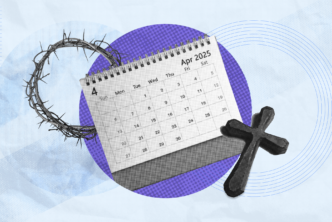Family devotion time: sweet memories or absolute mayhem? For most families, it’s a little bit of both.
We asked readers over social media—plus a few colleagues at Faithlife—to describe their family devotions and how they make the time meaningful and enjoyable. Based on the feedback, some readers seem to have the most attentive children alive, while others count doing anything a win. But they all agree about the bottom line: do what works. Forget perfection; just be consistent. What matters is that you are forming hearts and habits around God’s Word—together as a family.
1. I pray, read, and explain a Scripture passage, ask some questions about the passage, and apply it to our own family. My wife prays, and then we sing a psalm or hymn. It’s simple and short but often the best part of my day. —Brendon B.
2. Our daughter is only six months old, so right now we simply read the Bible and sing a few hymns or psalms from the Book of Praise after dinner. —Heidi B.
3. Ours is pretty simple because it means we might actually do it. We plan on one night each week, and we usually go through a book systematically one chapter or section at a time. (We just started introducing Emblems of the Infinite King.) Some weeks it might be reading a chapter of Scripture together and discussing it a bit. After that, I’ll play a worship song or two from a lyric video on YouTube. We sing along, and then we end in prayer. The simplicity of it has helped it become more of a regular rhythm for us. I have four kids, ages 2, 5, 11, and 13. —Micah E.
4. My family would read children’s storybook Bibles—different ones over the years, as age and understanding permitted. Then we would talk about the meaning. —J. Miller
5. First, we read. We cycle through three children’s story Bibles: The Biggest Story (Kevin DeYoung), The Jesus Storybook Bible (Sally Lloyd-Jones), and The Big Picture Story Bible (David R. Helm and Gail Schoonmaker). On Saturday nights we read the text being preached the next morning. Next, we have the kids pick songs to sing—usually the same selection every night! Then, we do one of the following, depending on the day of the week: children’s catechism, Bible verse memory, or listing the books of the Bible. Finally, we pray. Every Tuesday we work through the church directory and pray for different families; every Saturday we pray for the pastor and the congregation and the kids’ Sunday school class. It takes about 10–15 minutes—usually complete craziness, but our kids (twin five-year-olds and a two-year-old) look forward to it and make sure we don’t forget. —Nick B.
6. We do family devotions at dinner. We have a kids’ devotion about creation, then we do the devotions I write for our house church. It includes Scripture that we are reading as a church plus an activity, and then we pray at the end. We leave a Bible and the kids’ devotional book on our dining room table so we don’t forget to do it. The kids listen and participate well while they are eating their food. And it’s the one time of day when our entire family is home. It’s meaningful to us because it’s our “slow down and be together” time. It helps show the kids that slowing down and simply being is so important in our faith and how we practice it. At our house church, we exchange prayer cards, so we take time to pray from the cards we each get. We leave the cards in a visible place. We exchange prayer cards about once a month. Each month is usually a different request and person. It has their contact info on it, so we can text people to let them know that we or our girls are praying for them. Plus it’s awesome when we get texts from adults or teens about how they are praying for each of our girls. —Anh J.
7. We learned to limit our expectations for frequency, length, and detail if we wanted to maintain what could possibly be called a regular pattern. We’ve been using the New City Catechism off and on, working through it. The kids (ages 9, 8, and 5) do great at it. I also found that I struggled to read the Bible out loud in a way that wouldn’t make the kids fidget and make me get frustrated by interruptions—until we discovered The Bible Experience. It helps the kids to hear (1) different voice actors for each character, (2) actors who read with real emotion and expression, and (3) music and sound effects that help get the setting across. The translation used, the Today’s New International Version, is also just that much easier than the English Standard Version. I usually play a little bit of it, ask the kids a few questions, then repeat until we finish a passage. The kids do really great answering questions, especially if I let them fiddle with drawings or a toy. It looks like they’re not paying attention, but (I had to learn) they totally are. Then we usually sing one of a number of Scripture songs that I’ve collected and even written over the years—Bible words set to simple tunes. —Mark W.
8. Every night before bed my brother and I would beg my dad to read us a section out of a comic-book-style Bible. It was my first introduction to many stories in the Bible. Having something visual to connect with made me genuinely excited about the Bible from a very young age. —Ben P.
9. Before going to bed, we would pile into my parents’ bed and my dad would pray for us all. Not really a devotional, but it’s something that was powerful and lasting for me. —Christopher S.
10. We share communion together as a reminder of us dying to ourselves and remembering Christ’s sacrifice. —Scotty R.
***
The above ideas for family devotions appeared in the August 2020 edition of Ministry Team magazine.
Below we’ll share four more Bible study ideas for Christian families—all incorporating what you can do with Logos’s libraries as part of your devotional time as a family or even individually.
Now for four more family devotions ideas …
11. Work through different ways to study the Bible. Bible study should never be boring! There are so many paths to learning it better, and with Logos, they’re easy to teach.
Not only can you find every time a word appears in the Bible in seconds, then start reading through and discussing those verses right away.
You can also uncover the Bible’s big ideas and explain them to your kids with tools like these:
-
- Guides to biblical topics and doctrines
- Cross-references
- Thematic outlines
- Parallel passages
- Systematic theologies
- Background information
- Confessional documents
- Biblical places and people
12. Incorporate multiple ways to learn. This ties into what Ben P. said about the cartoon-style Bible he loved growing up. You know what they say: “A picture is worth a thousand words.” While the Bible provides an exception to that adage, our era is increasingly visual.
Logos helps you engage your kids in God’s Word by going beyond words. For example:
-
- Make learning Greek and Hebrew alphabets fun with the Alphabet Tutor. Your kids can hear each letter pronounced, see how to draw it, and practice drawing it themselves.
- Give your family a glimpse into the first-century world with interactive elements, including an interactive look at an empty tomb from Jesus’ era.
- Quickly access media to help your children visualize Scriptures—no need to pull out maps or atlases or take your chances on the internet.
13. Encourage safe searching. Internet searches are excellent for all kinds of things but not for studying the Bible and important topics. Here’s an example: Google search results change often, but a short while ago the first result for “agnosticism” on Google was a Facebook page naming it a “religious place of worship.” A few results down, “The 10 Truths of Atheism” appeared.
With Logos, your family can search for any word and see what the Bible and respected men and women have to say about that term. The results for “sex,” for instance, link sex with marriage and point to God’s instruction on sexual purity.
14. Do Q&A. Children ask some fantastic questions. Some of them are serious:
-
- “What does the Bible say about drinking?”
- “What does gospel mean (besides ‘good news’)?”
- “What happens when Jesus comes back?”
And some of them are just fun, like “Where does the Bible talk about foxes?”
Rewarding Bible questions with confident answers helps inspire your children to search the Bible for themselves. You don’t need a photographic memory for every verse and reference or keep every answer right on the tip of your tongue. Instead, go to Logos and find them together.
***
Family devotions help build a strong foundation in the faith and can hold some of your family’s fondest memories. Blessings as you undertake them!





